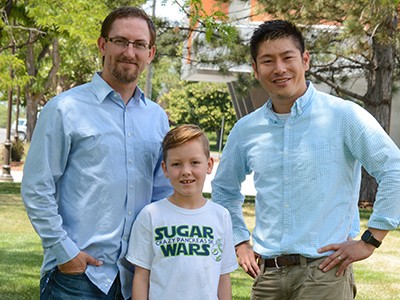Can Design of Wearable Technology Impact Health?
Chris Thurston checking his blood glucose levels.
Chris Thurston lives a pretty typical life for a 9-year-old; except that he just co-authored a research paper for a medical journal, and he manages Type 1 Diabetes during nearly every moment of his life.
Victor Lee, associate professor of Instructional Technology and Learning Sciences in Utah State University’s Emma Eccles Jones College of Education and Human Services, along with Chris’s father Travis Thurston, are co-authors of an article published in July 2017 in Methods of Information in Medicine on how data collection and its related discoveries are shaped by the design of wearable technology.
People often confuse Type 1 and Type 2 Diabetes. Type 1 is rare form of the disease that cannot be caused by lifestyle, and it’s considered more life-threatening because of extreme highs and lows of blood sugar that can occur even in patients’ sleep. Chris has a continuous glucose monitor (CGM) attached to his upper arm through a wire in his muscle. He also checks his glucose levels through frequent finger pricks that instantly measure the glucose in his blood.
Can the design of this type of equipment shape testing routines and therefore influence medical discoveries? Chris and his family recently answered that question by uncovering an anomaly with Chris’s blood sugar that led to a critical modification in the way he manages his disease.
A few months ago, referencing data collected over several years, Chris started experimenting with the timing of his insulin shot.
“For the first few days, I got my insulin shot, and then I ate 30 minutes later,” he said. “Then I tried eating right away after my insulin shot, and I noticed that my blood sugar went much higher.”
Because of the way the testing technology is designed, Type 1 Diabetes patients and their families typically will only see the data for the last three hours. There was an enormous spike in Chris’s blood sugar between breakfast and lunch, but since they hadn’t been testing specifically during that time, they weren’t seeing that data.
Lee observed that Chris’s family has been exceptional in the way they have obtained and stored medical data since Chris was diagnosed with Type 1 Diabetes at age two. An area of specialty for Lee is data science in education. He notes that families who engage in data science are taking advantage of a valuable asset. Chris’s parents have been extraordinarily diligent in their constant monitoring and extensive record keeping.
“The Thurstons are a regular, busy family,” said Lee, “but they have created clever routines, and they do a remarkable job with the daily management of carbs, soccer, insulin, exercise, et cetera.”
Episodes of high and low blood sugar occur frequently with Type 1 Diabetes and can be serious or fatal if not managed with extreme care.
“A spike in blood sugar like the one Chris was experiencing is hugely consequential for short and long term health,” said Lee. “It’s important for companies making this equipment to have an understanding of the day-to-day life of families and what prompts them to review the data like this,” said Lee.
Chris now waits for his insulin shot to take effect before he eats so his blood sugar no longer spikes after meals.
“We are gaining insight into how to help manage Chris’s condition—and this data becomes a consequential part of kids’ and families’ lives,” said Lee. “I’m excited to have published this paper with Travis and Chris, because they have figured out how to support learning in a swamp of data and data points,” said Lee.
Lee also pointed out that Chris performs nearly all of the data collection himself and is an essential participant in his own health management.
“Chris understands numerical ranges, data sets, digestive process, and other issues that make him a true co-author on this academic paper,” said Lee. With the strong support of his parents, Chris has used own his experience to build acceptance and awareness of Type 1 Diabetes.
Related Links:
Watch “Chris’ Quick Tips” on YouTube
Read the open-access research paper published in Methods of Information in Medicine
Writer and contact: Rebecca Dixon, Rebecca.dixon@usu.edu, 435-797-1463
Travis Thurston, Chris Thurston and Victor Lee.
TOPICS
Research 877stories Society 503stories Health 308stories Technology 139stories Diabetes 13storiesComments and questions regarding this article may be directed to the contact person listed on this page.










